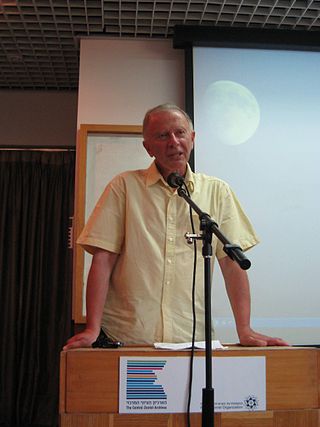Antisemitism is hostility to, prejudice towards, or discrimination against Jews. This sentiment is a form of racism, and a person who harbours it is called an antisemite. Primarily, antisemitic tendencies may be motivated by negative sentiment towards Jews as a people or by negative sentiment towards Jews with regard to Judaism. In the former case, usually presented as racial antisemitism, a person's hostility is driven by the belief that Jews constitute a distinct race with inherent traits or characteristics that are repulsive or inferior to the preferred traits or characteristics within that person's society. In the latter case, known as religious antisemitism, a person's hostility is driven by their religion's perception of Jews and Judaism, typically encompassing doctrines of supersession that expect or demand Jews to turn away from Judaism and submit to the religion presenting itself as Judaism's successor faith—this is a common theme within the other Abrahamic religions. The development of racial and religious antisemitism has historically been encouraged by the concept of anti-Judaism, which is distinct from antisemitism itself.
Some Christian Churches, Christian groups, and ordinary Christians express religious antisemitism toward the Jewish people and the associated religion of Judaism.
Antisemitism and the New Testament is the discussion of how Christian views of Judaism in the New Testament have contributed to discrimination against Jewish people throughout history and in the present day.

Semitic people or Semites is an obsolete term for an ethnic, cultural or racial group associated with people of the Middle East, including Arabs, Jews, Akkadians, and Phoenicians. The terminology is now largely unused outside the grouping "Semitic languages" in linguistics. First used in the 1770s by members of the Göttingen school of history, this biblical terminology for race was derived from Shem, one of the three sons of Noah in the Book of Genesis, together with the parallel terms Hamites and Japhetites.
Scholars have studied and debated Muslim attitudes towards Jews, as well as the treatment of Jews in Islamic thought and societies throughout the history of Islam. Parts of the Islamic literary sources give mention to certain Jewish groups present in the past or present, which has led to debates. Some of this overlaps with Islamic remarks on non-Muslim religious groups in general.
The history of antisemitism, defined as hostile actions or discrimination against Jews as a religious or ethnic group, goes back many centuries, with antisemitism being called "the longest hatred". Jerome Chanes identifies six stages in the historical development of antisemitism:
- Pre-Christian anti-Judaism in Ancient Greece and Rome that was primarily ethnic in nature
- Christian antisemitism in antiquity and the Middle Ages that was religious in nature and has extended into modern times
- Muslim antisemitism that was—at least in its classical form—nuanced, in that Jews were a protected class
- Political, social, and economic antisemitism during the Enlightenment and post-Enlightenment Europe that laid the groundwork for racial antisemitism
- Racial antisemitism that arose in the 19th century and culminated in Nazism
- Contemporary antisemitism, which has been labeled by some as the new antisemitism
Religious antisemitism is aversion to or discrimination against Jews as a whole based on religious doctrines of supersession, which expect or demand the disappearance of Judaism and the conversion of Jews to other faiths. This form of antisemitism has frequently served as the basis for false claims and religious antisemitic tropes against Judaism. Sometimes, it is called theological antisemitism.
The Stephen Roth Institute for the Study of Contemporary Antisemitism and Racism is a research institute at Tel Aviv University in Israel.

Racial antisemitism is prejudice against Jews based on a belief or assertion that Jews constitute a distinct race that has inherent traits or characteristics that appear in some way abhorrent or inherently inferior or otherwise different from the traits or characteristics of the rest of a society. The abhorrence may find expression in the form of discrimination, stereotypes or caricatures. Racial antisemitism may present Jews, as a group, as a threat in some way to the values or safety of a society. Racial antisemitism can seem deeper-rooted than religious antisemitism, because for religious antisemites conversion of Jews remains an option and once converted the "Jew" is gone. In the context of racial antisemitism Jews cannot get rid of their Jewishness.

Robert Solomon Wistrich was a scholar of antisemitism, considered one of the world's foremost authorities on antisemitism.
Anti-Judaism describes a range of historic and current ideologies which are totally or partially based on opposition to Judaism, on the denial or the abrogation of the Mosaic covenant, and the replacement of Jewish people by the adherents of another religion, political theology, or way of life which is held to have superseded theirs as the "light to the nations" or God's chosen people. The opposition is maintained by the appropriation and adaptation of Jewish prophecy and texts, and the stigmatization of the very people who transmitted those texts. According to David Nirenberg there have been Christian, Islamic, nationalistic, Enlightenment rationalist, and socio-economic variations of this theme.
Antisemitic tropes or antisemitic canards are "sensational reports, misrepresentations, or fabrications" that are defamatory towards Judaism as a religion or defamatory towards Jews as an ethnic or religious group. Since as early as the 2nd century, libels or allegations of Jewish guilt and cruelty emerged as a recurring motif along with antisemitic conspiracy theories.
Anti-Judaism in Early Christianity is a description of anti-Judaic sentiment in the first three centuries of Christianity; the 1st, 2nd, and 3rd centuries. Early Christianity is sometimes considered as Christianity before 325 when the First Council of Nicaea was convoked by Constantine the Great, although it is not unusual to consider 4th and 5th century Christianity as members of this category as well.

Antisemitism has long existed in the United States. Most Jewish community relations agencies in the United States draw distinctions between antisemitism, which is measured in terms of attitudes and behaviors, and the security and status of American Jews, which are both measured by the occurrence of specific incidents.

"Concerning the Jews" is an 1899 short essay by Mark Twain. Twain had lived in Austria during 1896, and opined that the Habsburg empire used Jews as scapegoats to maintain unity in their immensely diverse empire.
Allosemitism is a neologism that encompasses both philosemitic and antisemitic attitudes towards Jews as the Other.
Anti-antisemitism is opposition to antisemitism or prejudice against Jews, and just like the history of antisemitism, the history of anti-antisemitism is long and multifaceted. According to historian Omer Bartov, political controversies around antisemitism involve "those who see the world through an antisemitic prism, for whom everything that has gone wrong with the world, or with their personal lives, is the fault of the Jews; and those who see the world through an anti-antisemitic prism, for whom every critical observation of Jews as individuals or as a community, or, most crucially, of the state of Israel, is inherently antisemitic". It is disputed whether or not anti-antisemitism is synonymous with philosemitism, but anti-antisemitism often includes the "imaginary and symbolic idealization of ‘the Jew’" which is similar to philosemitism.
Zionist antisemitism or antisemitic Zionism refers to a phenomenon in which antisemites express support for Zionism and the State of Israel. In some cases, this support may be promoted for explicitly antisemitic reasons. Historically, this type of antisemitism has been most notable among Christian Zionists, who may perpetrate religious antisemitism while being outspoken in their support for Jewish sovereignty in Israel due to their interpretation of Christian eschatology. Similarly, people who identify with the political far-right, particularly in Europe and the United States, may support the Zionist movement because they seek to expel Jews from their country and see Zionism as the least complicated method of achieving this goal and satisfying their racial antisemitism.
Antisemitism in the People's Republic of China is a mostly 21st century phenomenon and is complicated by the fact that there is little ground for antisemitism in China in historical sources. In the 2020s, antisemitic conspiracy theories in China began to spread and intensify. Some Chinese people believe in antisemitic tropes that Jews secretly rule the world and are business-minded.
When antisemitism accusations are exploited for political purposes, especially to counter criticism of Israel, it may be described variously as a weaponization of antisemitism, instrumentalization of antisemitism, or playing the antisemitism card. Such accusations have been criticized as a form of smear tactics and an "appeal to motive". Some writers have compared this to playing the race card. When used against Jews, it may take the form of the pejorative claim of "self-hating Jew".






